Periscope (ペリスコープ) was an electro-mechanical game released in multiple international markets in the mid-60’s. In the game, a player is tasked with aligning their viewport – stylized as a submarine Periscope – with ship targets on the other side of a plexiglass sea. When a player pushes a button attached to the Periscope, a mortar is sent flying, represented by a lit object travelling across the play area to the other side. When it hits either the sea or a ship, a sound of destruction is heard, and if the latter occurs there is an extra visual effect of an explosion in the distance.
This game was revolutionary for a number of different reasons, both in its presentation as well as helping to standardize a quarter per-play in the United States, but the question of who can claim credit for developing the game has flared up in recent years.
The two primary candidates for the creation of the game are Japanese amusement companies Sega Enterprises Ltd. and Nakamura Seisakusho Co Ltd. (later Namco). Both companies have the game listed in official site timelines with Sega listing Periscope as being released in 1966 and Namco listing the game as 1965. No official acknowledgment of the other has been posted by either in this matter, at least not to my knowledge, and therefore we are left with conflicting and unsupported accounts of timeline and ownership.
In this post we will be examining the various claims and sources which support the myriad of sides to this story. Nothing conclusive has yet been found which definitively gives credit to one company or other. While Sega is currently in the history books with its own claims, it is worth acknowledging all the available evidence in order to draw conclusions.
Nakamura Seisakusho Co Ltd. (中村雅哉)
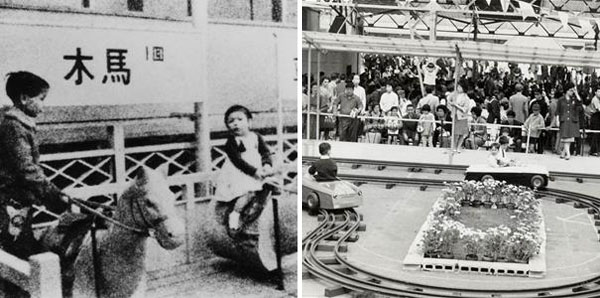
For a bit of quick background on Nakamura Seiaskusho (translated as Nakamura Manufacturing in the trade press) you can listen to Alex Smith’s podcast which deals with the founding of the company. While not worth dwelling on for our purposes, I will note that a few translated sources imply both that Masaya Nakamura may not have founded the company with his father and that they may have started their business as building rocking horses rather than manufacturing guns, which Alex acknowledged in a later episode (Baba 1993, pg 150-151).
The long and short of it is that Masaya Nakamura was a shipbuilding engineer that got involved with rooftop amusement spaces when he was contracted by the Mitsukoshi department store to build a custom area called Roadway Ride in 1963. As the opportunities for his specialization began to decrease, with companies like Taito and Rosen Enterprises offering full service amusement for the booming department store areas, Nakamura Seiakusho Co Ltd. began manufacturing kiddie rides with various licenses. According to Namco’s historical game listing, they began this in 1965.
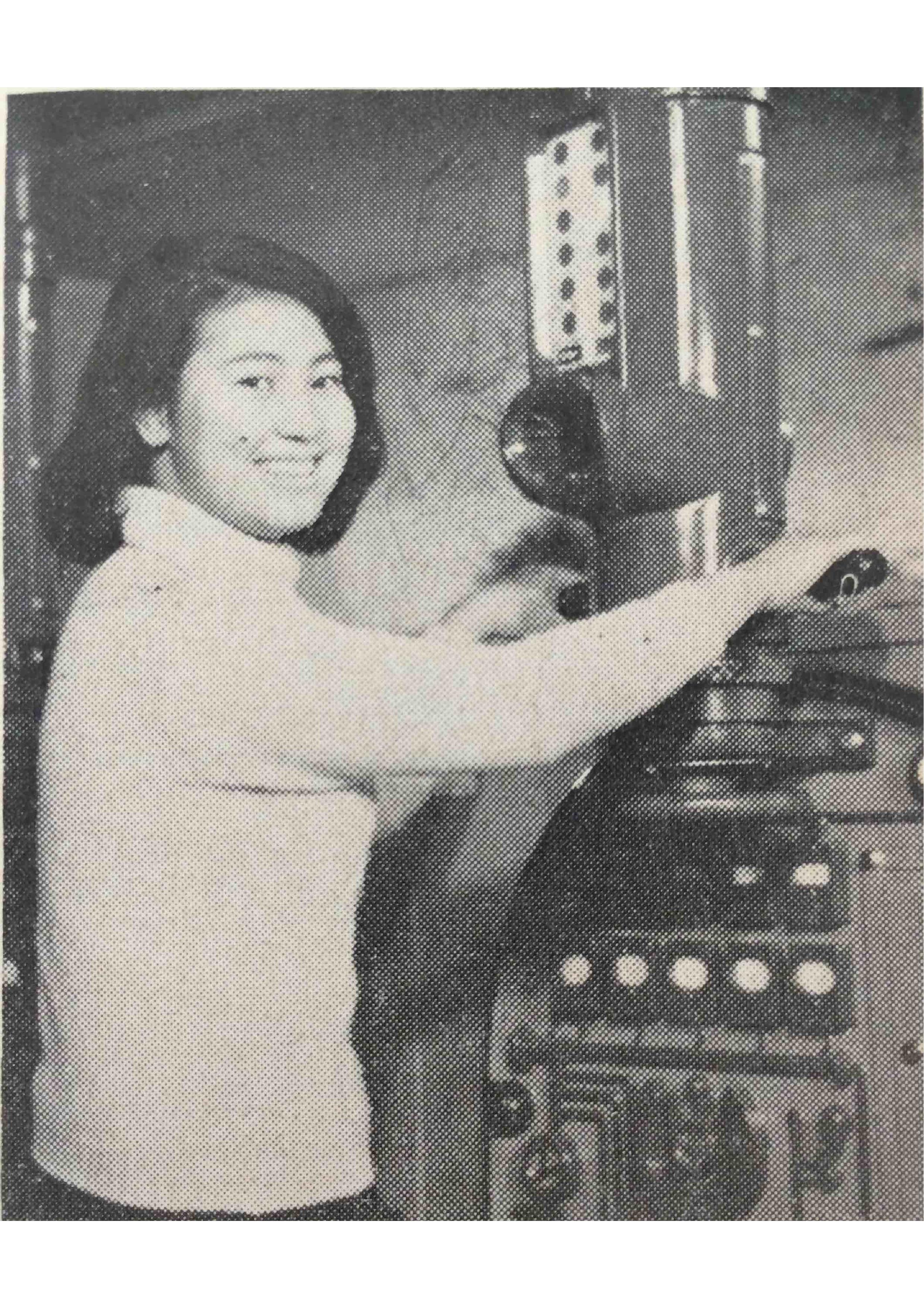
Also in 1965 is when the Nakamura Periscope was supposedly built. Having no little access to Japanese publications, there is no direct evidence that this timeline is accurate. The only contemporaneous source available in English is a picture and small article in the April 15th, 1967 issue of Cash Box which warrants the company’s first known mention in any English source. The unit is designated at NP-3D and Masaya Nakamura says he will give special attention to those looking to import the game from elsewhere in the world. This confirms at least that one version of Periscope existed by that time, one which visually appears slightly different to Sega’s own model (which we will discuss later).
Following that, in the January 1977 issue of Play Meter, Masaya Nakamura was interviewed by Ralph Lally. Here is the transcript that relates to Periscope:
Play Meter: What was the first amusement device that you built?
Nakamura: It was a submarine game, called Periscope, a three-player game, three periscopes set up in parallel.
PM: And what was the next step from there?
N: Then we made a tank game adapted from a big tank battle between the Allied forces and German forces during the second world war.
PM: When you started manufacturing, did you sell these games to your competitors, the operators you had been distributing to?
N: Yes.
PM: The submarine game that you mentioned sounds like Seawolf, yet this was ten years ago: would that be the first periscope game ever?
N: I don’t believe so, but it was the first famous submarine game in Japan. I think there were some similar games before. However this was the first famous periscope game. (Lally 1977)
Alex Smith has reckoned that being described as the first ‘famous’ submarine game relates to Sega’s international success with Periscope. As mentioned, any sort of evidence of a deal between Namco and Sega for this game has not yet appeared beyond speculation. Alex does point out though that members of Kasco, another Japanese coin-op manufacturer, stated in a retrospective interview available in English on Shmuplations that Sega was a major outlet for international releases of games. As far as I know, Kasco never went through Sega, but they also did not release many games stateside.
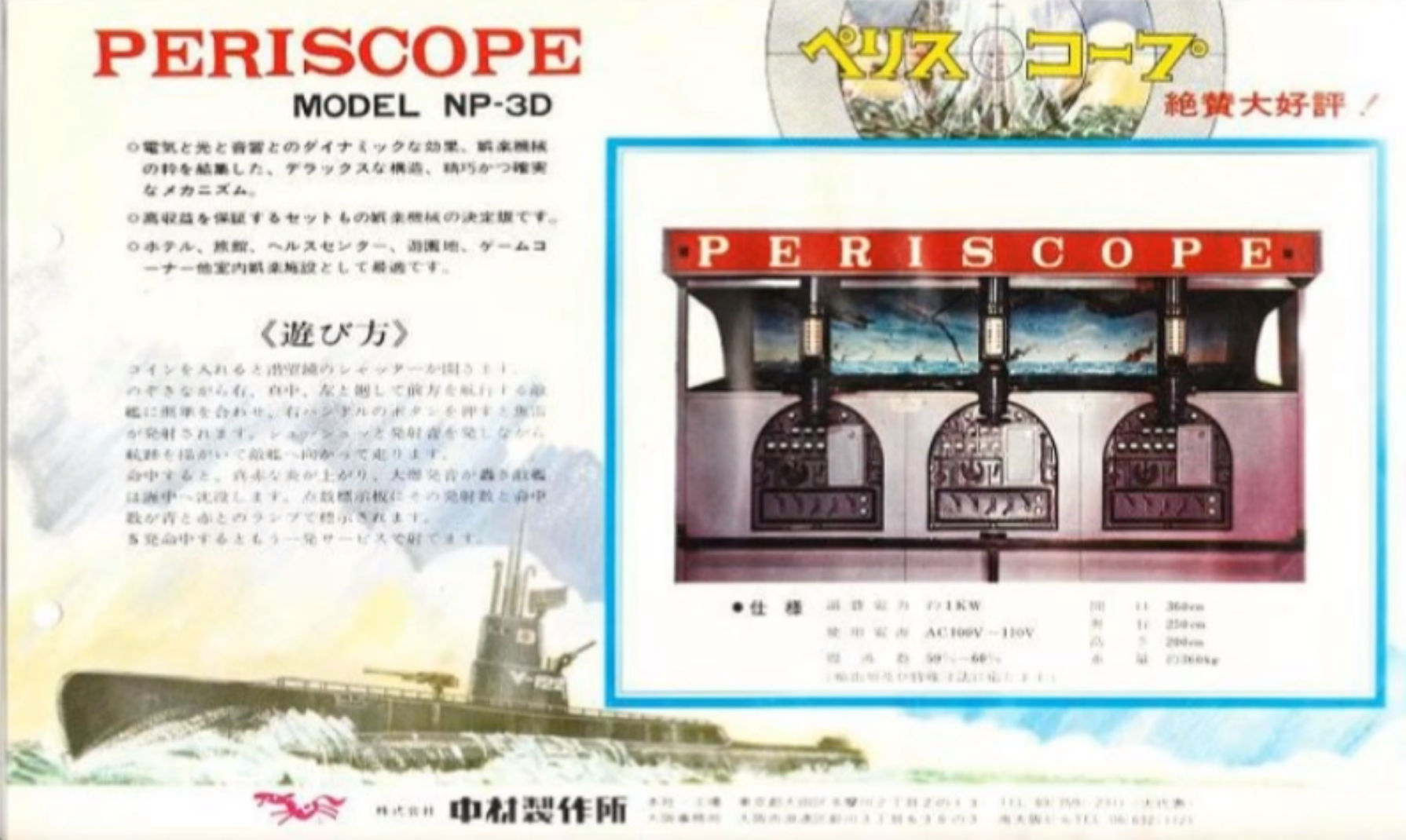
The next piece of evidence is a flyer which can be seen on the Namconian blog and in an enlarged version on this Youtube video. I can confirm that the Kanji on this poster does read Nakamura Seiaskusho Co. Ltd., but I can also confirm that the poster has no date on it. The Youtube video states that in the Japanese Time Crisis 2 strategy guide, a timeline states that Periscope was a 1965 game.
Another piece of visual evidence was posted by the Japanese user onionsoftware on Twitter, showing a Periscope game which is dated from ’65-66′. This image comes from the booklet “Namco Museum 1955-1984”, and it also appeared in the earlier version “Namco Museum 1955-1982” with only ’65’ listed as it’s date.
The first comment chain in this Twitter post, from Area51_zek, describes some further details about this image. He first states that the product was originally known as 魚雷発射機 which in Kanji translates as “Torpedo Launcher” before later being called Periscope. This is supported by an image of the game appearing in Akagi (2015) (pg 51) with the same label.
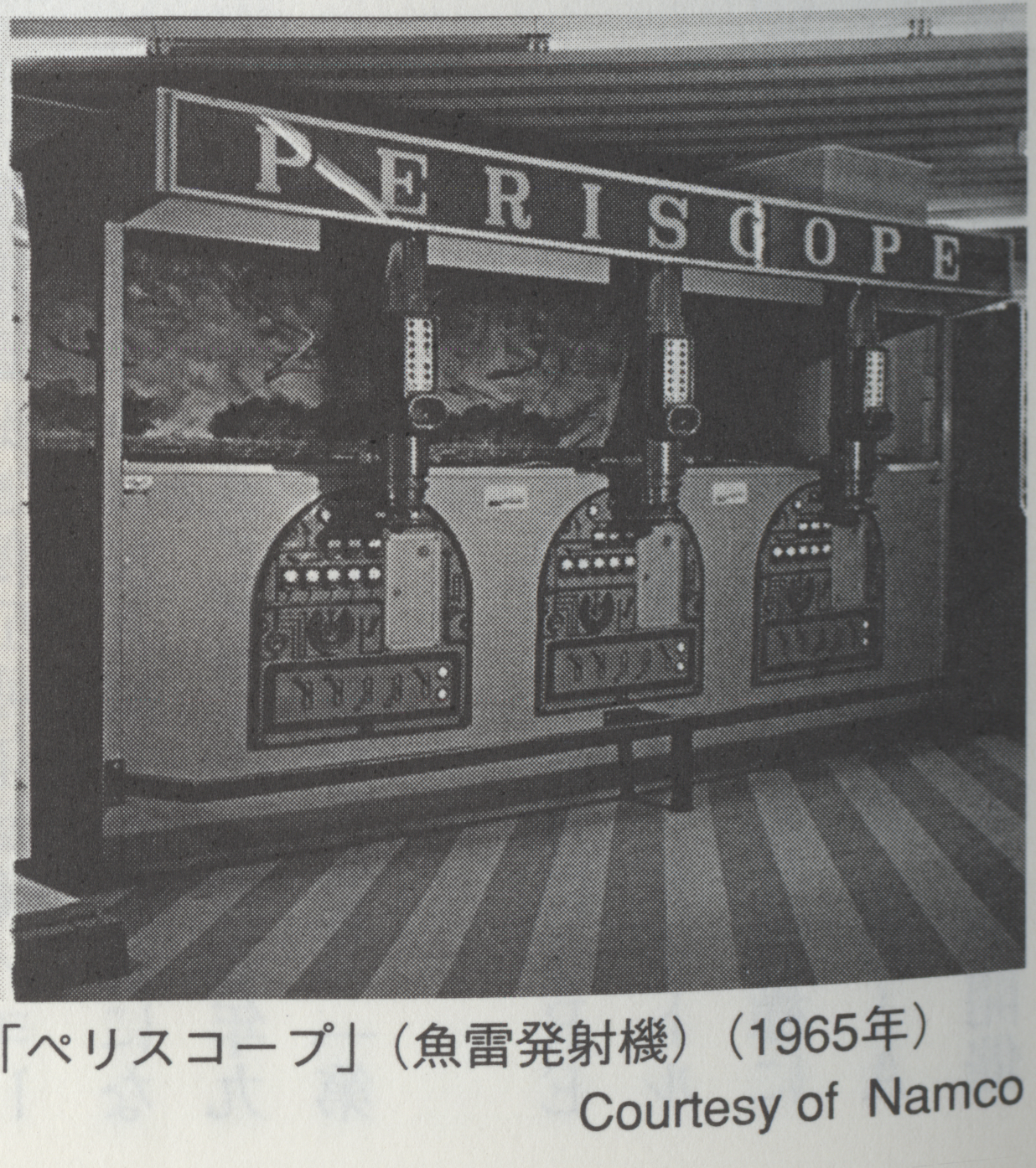
However, Area51_zek points out an inherent contradiction in the aforementioned book. When discussing the Nakamura Periscope, author Akagi says something to the effect of the design being different than that of Sega’s Periscope (which he describes in an earlier chapter), yet he lists the Nakamura game as 1965 and the Sega game as 1966 (Akagi 2015, pg 43, 50).
These pieces of evidence have led Alex Smith to posit that perhaps Periscope originated as a custom rooftop installation model, similar to Nakamura’s Roadway Ride. Nakamura was just starting to build amusement items starting in 1965 and they did not build a factory in Tokyo until February of 1966 (Akagi 2015, pg 50). It would make sense if Nakamura made the first model in 1965 for a specific venue and then was not able to go into larger production until 1966 or 1967, which is when Cash Box first noticed it.
Periscope is also mentioned in connection with Masaya Nakamura in the seventh issue of a publication called AM Life in 1983, though with no further detail. The JAMMA website also prints the picture from the Twitter post with a note of the game being from 1965 and the Sega version being 1966.
This ends all the resources I have been able to find relating to Nakamura Seisakusho Co Ltd. and Periscope. The fact that the Nakamura Periscope is very sparsely covered could have as much to do with the company’s size as much as its relation to Sega. It is very logical to draw the conclusion that when Masaya Nakamura relates Periscope as being Japan’s first ‘famous’ submarine game, he likely wasn’t referring to the original model. However, let’s not discount the evidence that Sega may have originated the concept, as their end is well documented, even if many of the pieces of evidence contradict themselves.
Sega Enterprises Ltd. ( セガ・エンタープライゼス)
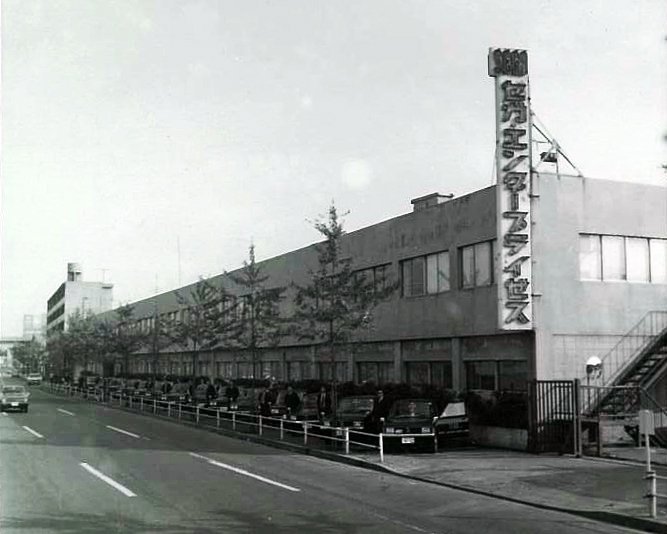
Again, I will direct readers to Alex Smith’s podcast if you want to catch up on the pre-history of Sega Enterprises Ltd., as well as a second episode on its start to growing into a powerful force in the early arcade era. What’s important to relate here is that even though Sega Enterprises Ltd. was a new company, they did have a factory that had been creating slot machines (and possibly games) for a while.
The first mention of Sega’s Periscope comes out of a London based trade show called the ATE which opened on November 28, 1966. It is important to point out that Cash Box has the description of “the Sega Version of the Torpedo Shoot Periscope game”. “Torpedo Shoot” is actually a different game which will be discussed in the third section of this article, and the claim of it being a version of a previously existing game will also be discussed.
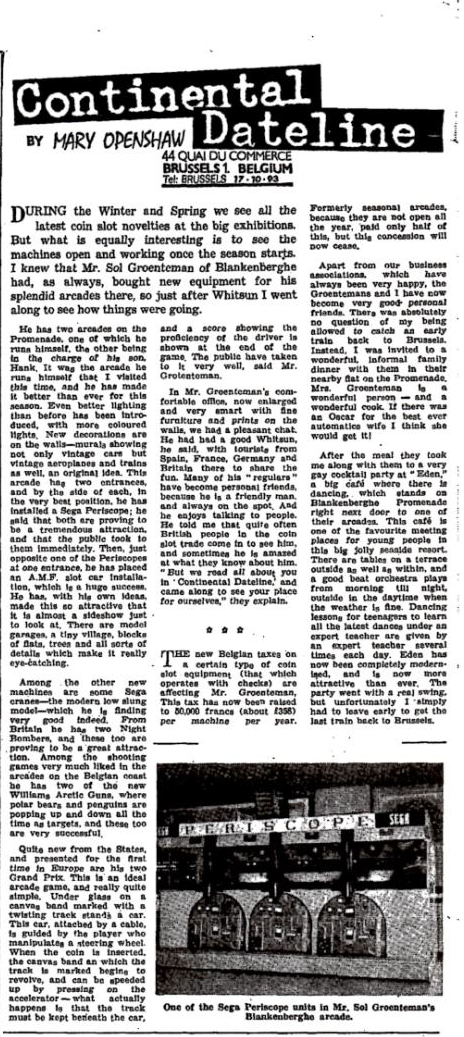
The first photo of the Sega Periscope game appears in a European coin-op publication called Coin Slot in the June 24, 1967 issue. The article speaks about an installation of Periscope in a Belgian arcade, and some of the information is repeated in July 27, 1968 issue of Cash Box. Freddy Bailey, the excellent European coin-op historian who provided this information, says that Marty Bromley of Sega Enterprises Ltd. was a partner in this arcade, and that the owner Hank Grant told him that the unit was first installed in April of 1967.
Subsequently, the Sega Model was showed at the Hotel Equipment Exhbition in Paris starting on October 12, 1967. This would be the last seen of the model in English language publications until they decided to take the machine stateside.
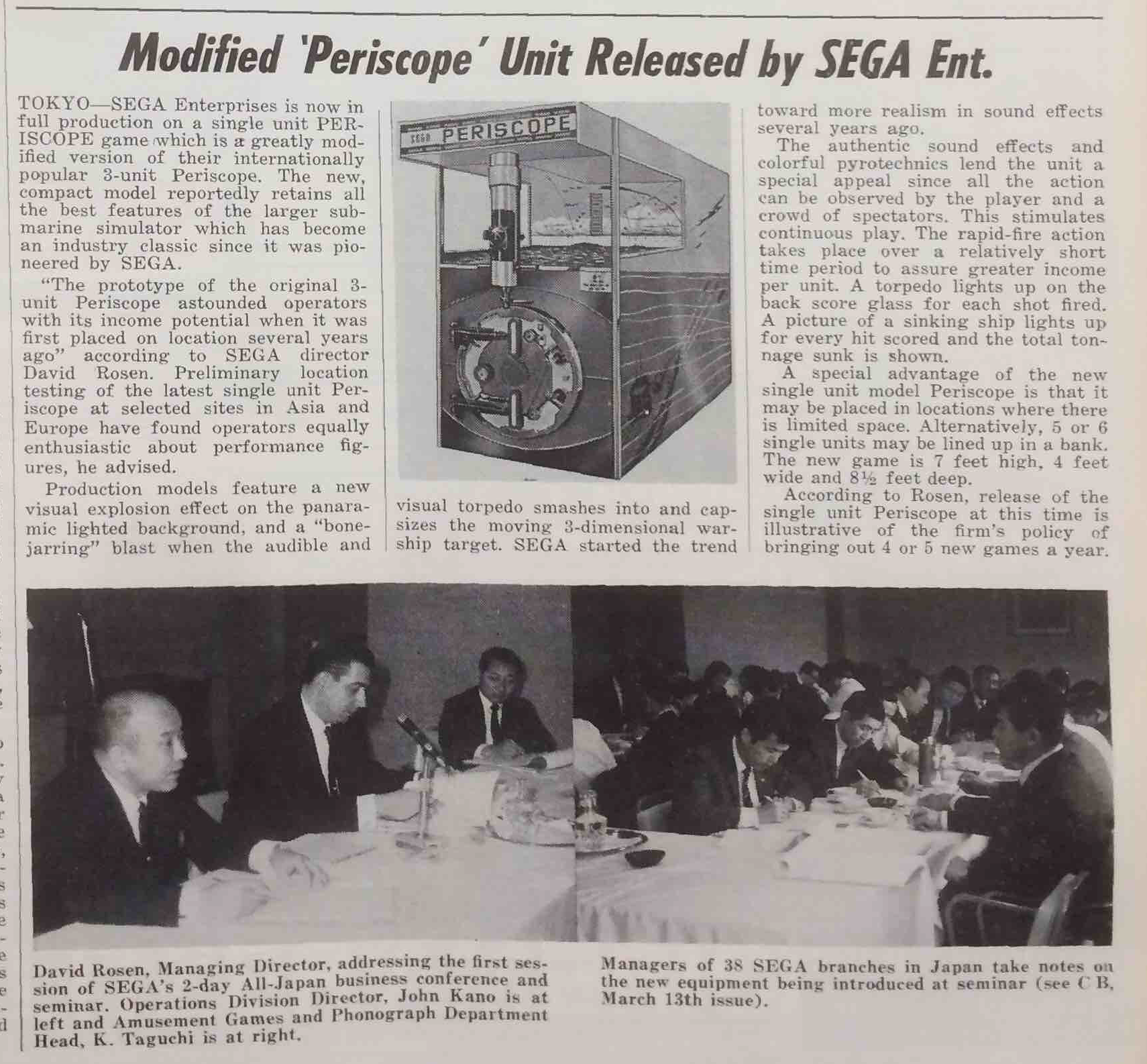
The launch announcement for Sega’s Periscope in the March 23, 1968 issue of Cash Box is packed with interesting info for both this specific game and the company as a whole. What is made clear through this piece is that Periscope is continually referred to as a game with some age. Cash Box refers to it as “an industry classic” and David Rosen says the original game “was first placed on location several years ago”. For the American market, the design has changed to a model which houses only one set of controls, probably to minimize the cost of importing (Sega did not yet have an American manufacturing operation at this time).
So all of this establishes that Sega’s Periscope definitely existed in 1966 and that it first came to the American market in March 1968 in a single unit version. Since almost every listing of the game states an initial creation date of 1966, there is no need to go back over that with subsequent claims. Instead, we’ll look at the circumstances behind the game’s creation, which is reported differently in almost every source I’ve been able to find.
The earliest version of this story comes from Oshita (1992). In this book, the author claims that Sega started creating games in 1966, the first of which being Basketball which was based off an American game of some kind. There are references to earlier Sega games being produced, but the point of creating Periscope was supposed to be a directive for creating original content (Oshita 1992, pg 104).
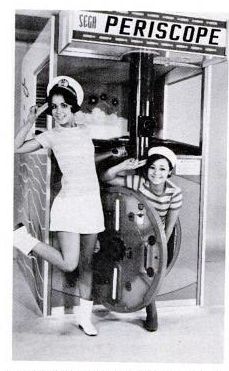
The head behind this initiative and the project was an engineer named Ochi Shikanosuke (whose name appears in a number of very important Sega patents), and they finished the project in Spring of 1966. The book goes on to describe the game being debuted at the 1967 “ATA” (probably the 1966 ATE) show in London, where distributors started playing the game whilst Ochi was repairing it, being very impressed with the audio-visual magic on display (Oshita 1992, pg 104-106).
The next mention is from Akagi (1993). As a preface to speaking about the game, the author speaks about popular media featuring submarines. The first two he mentions are Hunt for Red October and Silent Service, both media pieces that did not appear until the 1980s. However, assuming that he is speaking about those two media properties in a contemporaneous context may be a result of my poor translation. In the following sentence he speaks of Submarine 707, which was a manga around at the time, as an inspiration for the game (Akagi 1993, pg 35-36).
The final story, and one that has leaked to the English speaking world, comes from Akagi (2015). In this telling, David Rosen sketched out the design for Periscope and it was built in 1966 (Akagi 2015, pg 43). Later in the book, it is mentioned that Ochi Shikanosuke had been the head of Sega’s development efforts since Periscope (Akagi 2015, pg 143). As mentioned in the prior section, it is claimed that Nakamura’s Periscope was unrelated to this one, ‘different’ is the translated word.
Let’s speak about differences in the design of the two versions. Only one brief clip of Sega’s Periscope model displays the machine’s general function, but you can see a fuller recreation of it in action in the above Youtube video as well. One can also view the Sega three Periscope Model in lovely detail in a brochure posted on Sega Retro. Unfortunately for the Nakamura model the pictures aren’t as pristine, but give us enough of an overview to notice some outward aesthetic changes.
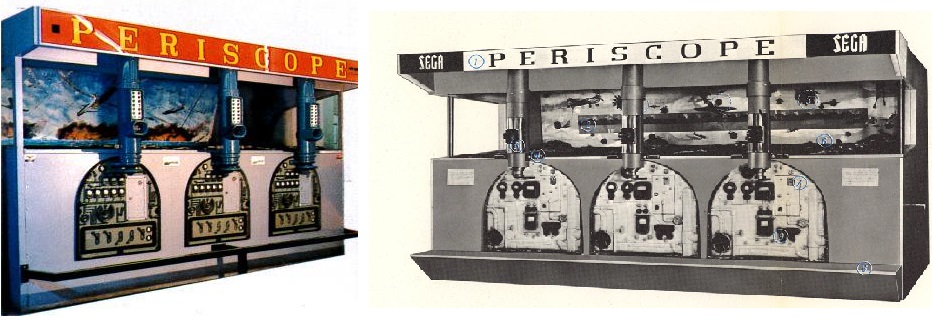
We can assume that functionally, if not mechanically, the Periscope models are the same. All indications point to the same sort of gameplay being in both versions, if not all the features. The most noticable difference that can be seen in the outward construction of the Nakamura version and not so much in the Sega version are the visible rivets right above the viewport. Right below the periscope itself, the panels which adorn the front are quite different, though both are housed within the same general shape. The backglass is clearly different between the two, though both show planes and warships on fire over an ocean. The Sega version has white rectangles on the outer edges (which are presumably instructions) and the Nakamura version has them in between the Periscopes. Lastly is the marquee, the top of which on the Nakamura version has no indication of a company visible while the Sega logo adorns the top of the other.
So are these versions really ‘different’ to each other in any substantial way? I feel that it’s likely that Akagi (2015) was attempting to hastily explain away a contradiction which wasn’t at the center of his research, since none of his sources in the back of the book seem to indicate that he knew the Nakamura side of the story very well. Onionsoftware told me about his correspondence with Masumi Akagi on the matter, and said that he was uncertain about the game’s origins, believing that it may have even been based on an American game.
So before we rest the debate on the two Japanese companies’ merits, there is actually a third side to this story. We will also be clearing up some misconceptions about some similar, but unrelated games.
Mayfield Electronics Ltd. and Nixsales Ltd.?
While I wish I could provide any sort of easy explanation for these two British companies, the information from the United States coin trades are incredibly scarce. Mayfield Electronics Ltd. (also affiliated with a company called Mayfield Automatics) was a Lancashire based manufacturer of a wide variety of coin-operated equipment including slot machines, puppet shows, and forty person slot car race tracks. The company draws its first mention in Cash Box in August 1964 and closed in 1972. Nixsales Ltd. (also known as Nixson) was apparently from Sussex and may have manufactured a coin pusher around 1967.
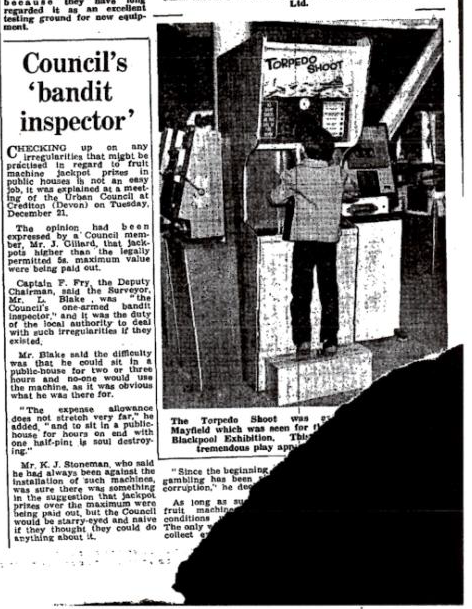
In about 1965, Mayfield introduced a game called “Torpedo Shoot” to the British market. This game was not the same as Nakamura’s or Sega’s Periscope, though it had some similar characteristics including sound effects. Instead it was a self-contained target shooting game of the like which were very popular in the 1960s where players shot missiles in the dark. In fact this game may have been based off of a 1940s unit by Bally called Undersea Raider, sometimes referred to as Periscope, which again has nothing to do with the elaborate mechanics of the Japanese versions. Taito also had the same kind of game and called it Periscope, but all of these games have (seemingly) nothing to do with the Periscope we’re speaking about.
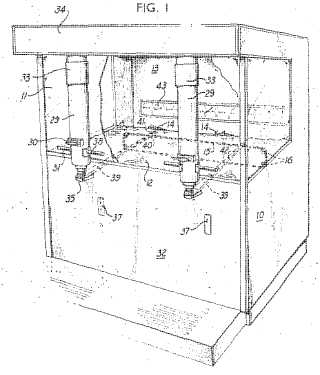
Mayfield Electronics had a possible relationship with Sega, being in the slot machine business, and some patents in the 1990s actually reference Mayfield Electronics work (though none of it relating to Periscope). However, on December 16, 1966 Mayfield Electronics filed for a patent (with a priority of the same date) for “A New or improved Indoor Game Apparatus” by inventor Edward Oswald Carter. Viewing the patent drawings, it is very clear to see that the machine is extremely similar to Periscope, but in a two-player version rather than three or one.
Sega along with the two British companies are referenced in the February 11, 1967 issue of Cash Box regarding the upcoming Northern Amusement Equipment and Coin Operated Machine Exhbition in Blackpool which opens on the 27th. Directly comparing Sega’s machine (though still calling it ‘torpedo shoot’) both Mayfield Electronics and Nixsales are said to have new models available at the show, fitting in well with Mayfield’s patent date.
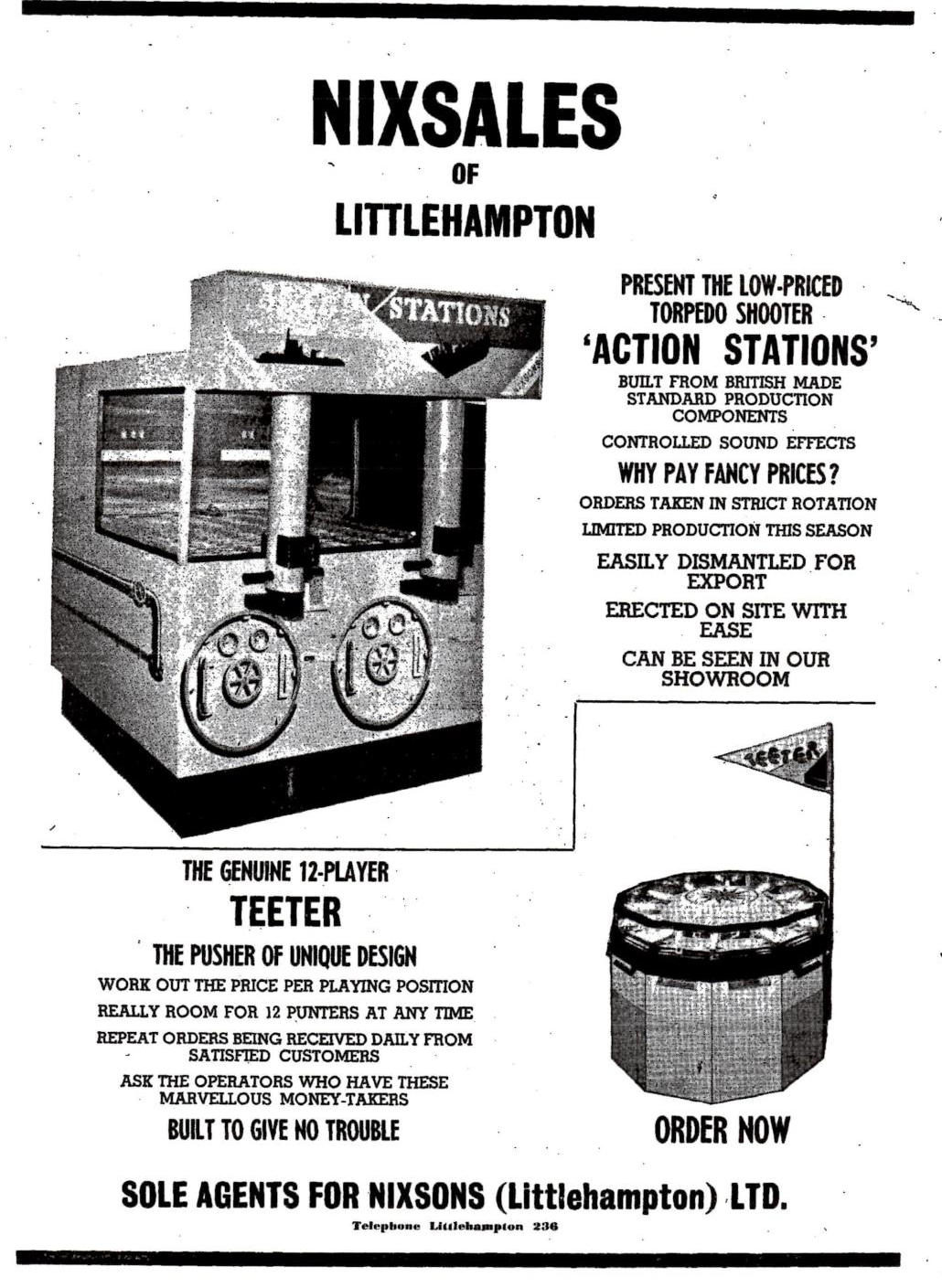
The first visual appearance of these two player models comes from Nixsales Ltd. on March 4, 1967 in Coin Slot labelled as the “Action Stations”. Viewing the ad shows a possibly cheaper version of the Periscope game; definitely too wide across to be a traditional shooting game set-up.
Mayfield Electronics’ version, called Submarine Patrol, appears in the November 11, 1967 issue of Coin Slot where it is stated to have been previewed by Mayfield’s Managing Director E. Carter (presumably the Edward Oswald Carter who invented it).
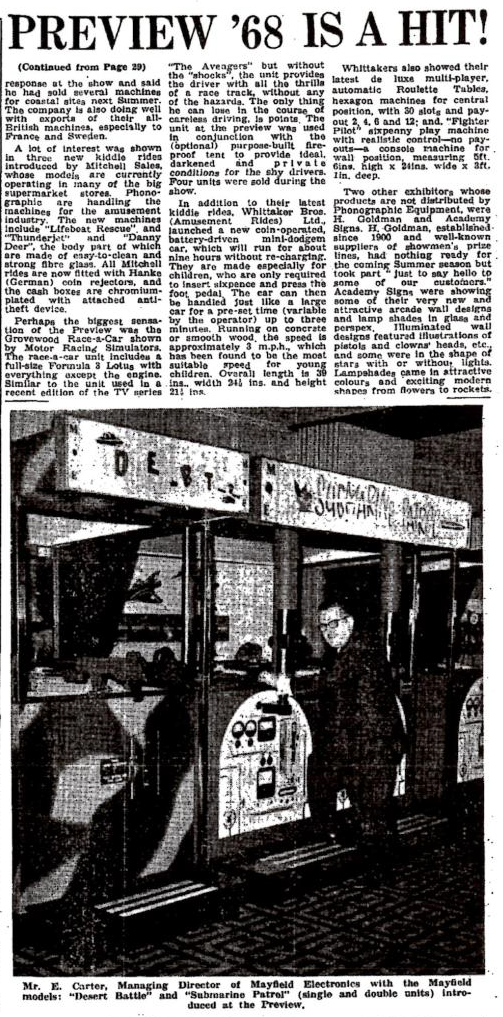
So what does this all say? Well, the most interesting part of this whole affair is that Mayfield actually patented the Periscope-alike, and did so mere weeks after the ATE show where Sega first showed Periscope in Europe. Sega, as far as I’m aware, never patented anything relating to Periscope (though interestingly enough, they did patent some slot car technology, a field Mayfield was also in). However, Japanese patent websites at the moment do not allow for viewing back to the 60s, so it cannot be proven whether or not any of the companies attempted to do so in Japan.
The immediate conclusion to draw from this is that Mayfield Electronics stole and patented Sega’s work after viewing it at the ATE show, but when I was first putting these pieces together I had thought for a moment that Mayfield may have actually been the original developers of Periscope. That is not nearly as likely as Nakamura originating it, but if you believe that Nakamura may have licensed it to Sega with no mention, there’s a possibility Mayfield could have as well. The context of the times does lean heavily against this though.
Conclusion
So what to say about the authorship of Periscope? The game has a legendary status in the coin-operated games industry in Japan, Britain, and the United States. Figuring out the authorship with help increase our understanding of the companies involved and how this game came to be as big as it is. Lacking that information has given us some avenues to understand the late 60’s coin-op industry better, but provides more questions as we speculate the origins of this machine.
Alex Smith wholly believes that Nakamura created the machine, that Sega ripped it off, and that these British companies copied Sega. His reasoning is that Sega probably didn’t have the facility to build a game as complex as Periscope all by themselves, but that there is no indication of a license. In fact, if it was licensed, why would Masaya Nakamura be offering direct import assistance in the April 15th, 1967 issue of Cash Box? If he already had a partnership with Sega, who was already showing the game in Europe, there would theoretically be no need to solicit importers. Though, it must be said, the Japanese market was largely built on licensing to multiple companies up until about 1982, so it’s not entirely out of the question.
Believing that Sega created the initial model creates the least contradictions in the story, as Masaya Nakamura only claimed that Periscope was the first game – not the first original game – that his company created. This thought does conflict with the claimed dates though and deductive reasoning. It could very well be that Periscope originated in the same manner as Roadway Ride as a one-off piece until it gained notoriety. It could well be that David Rosen scribbled a design down based on this machine and that Shikanosuke Ochi made it a reality. There is some kind of broken link in this chain we know nothing about.
I leave it to you to deduce based on all the sources available. I hope this was a comprehensive enough view of the whole ordeal. Feel free to send me questions or information that you may have. I will update this article if anything new comes to light.
Update #1: I received some further information from @onionsoftware which has been added to the post. He clarified both the origin of the color Periscope picture as well as told me about his correspondence with Masumi Akagi. ありがとう武田さん!
Update #2: Added a link to a British film reel which briefly featured Periscope.
Update #3: The latest version of this article now lies at Gaming Alexandria. Any future updates will be edited in there.
Thanks:
Alex Smith for endlessly fascinating conversations and historical insight.
Freddy Bailey for all of the European coin-op information.
Keith Smith for great source compilation and background on these coin-op companies.
Sources:
Akagi, Teppei (赤木哲平). October 20, 1993: セガvs.任天堂 : マルチメディア・ウォーズのゆくえ
Akagi, Masumi (赤木真澄). March 10, 2015 : それは「ポン」から始まった-アーケードTVゲームの成り立ち
Baba, Hironao (馬場宏尚). August 25, 1993: セガに怯える任天堂
Lally, Ralph. January 1977: Play Meter

I have some info on Nixsales and the Periscope saga if you are still interesed
LikeLike
Absolutely! I’m very interested to know. You can post it here or contact me via the contact page. https://thehistoryofhowweplay.wordpress.com/contact/
LikeLike
Wow, what a fantastic article. Really felt I learned a lot reading it.
LikeLike
Thank you Cat! Love your work as well.
LikeLike
Fully aware this article is now two years old, but this was a great read. Props for finding all of this stuff and weaving them into an article.
LikeLike
Thank you! I did slightly update it and post it on Gaming Alexandria.
LikeLike
Thank you for the wonderful article.
Some information from Japan.
Translate part of the periscope of this article into English.
https://books.google.co.jp/books?id=Xc8OEAAAQBAJ&pg=PA10#v=onepage&q&f=false
This article was written by Area51_zek.
* I am an ordinary person who has nothing to do with writers, magazines, and Namco.
—–
On June 1, 1965 (Showa 40), we celebrated the 10th anniversary of our founding, and in commemoration of that, an in-house newsletter was launched.
Furthermore, a manufacturing department was established, and it became possible to develop original products in-house.
The first was a “rock-paper-scissors machine” with the theme of rock-paper-scissors, and the second was a “periscope” with the theme of a submarine torpedo battle.
(Omitted)
At that time, December was the end of the year, and one “periscope” was left unsold until the end, and the price of the aircraft was as high as 1.8 million yen, so it was not good to keep it in stock over the years.
While it was snowing, I visited the dormitories one by one with the Kusatsu Onsen district in the midwinter in one hand, and on December 29, when the evening was approaching, the Daitokan in front of Yubatake agreed to introduce it.
The employees who were most in charge of the installation work went to work from the end of the year to the New Year, so I was complained, but I got nothing.
LikeLike
Thanks very much for that! I remember Zek informing me of this publication but I never ordered it. Very interesting information, though I wish he cited it. I can try asking him directly though.
One question if you may know, when it talks about the rock-paper-scissors game is it using the word “じゃん拳”? I’m sure Zek would have clarified if he knew what this machine was specifically.
LikeLike
I think that article is the best summary of Namco’s history that I can read today.
In particular, the story of Masaya Nakamura from his childhood to his days at Nakamura Seisakusho is one that I don’t think is well known outside of Japan.
For example
Masaya Nakamura’s father was a gun repairman, but he was also in the business of setting up 射的(Japanese shooting gallery) and other amusement equipment.
Everything was lost during the war except for the repair tools, but after the war, the company recovered due to the high demand for guns for hunting and other purposes.
Masaya Nakamura and his father were co-owners of a company, but Masaya left the company due to conflicts over the management of the company.
Masaya Nakamura wondered what kind of work he should do, but after seeing children playing in the burnt ruins after the war, he wished to create a place like Asakusa Matsuya and started Nakamura Seisakusho at his wife’s parents’ house. With his brother-in-law and a female office worker.
じゃんけんマシーン
I have never seen the Nakamura Seisakusho’s “Janken Machine” before, not even in photographs.
However, “Janken” is very popular in games as well as with actual hands.
This is the “Janken Man” game machine for children, which was a big hit in 1985.
I don’t know if it was influenced by Nakamura Seisakusho’s “Janken Machine”, as it is too old.
LikeLike
you can see Nakamura’s ジャンケンマシン here: http://thetastates.com/elecmeca/1969prior.html
Komaya also released a janken game the same year, グーチョキ パー.
I found a newspaper article from USA, 1903, talking about the new “rock-paper-scissors” game from Japan. How long is the history of janken in Japan?
LikeLike